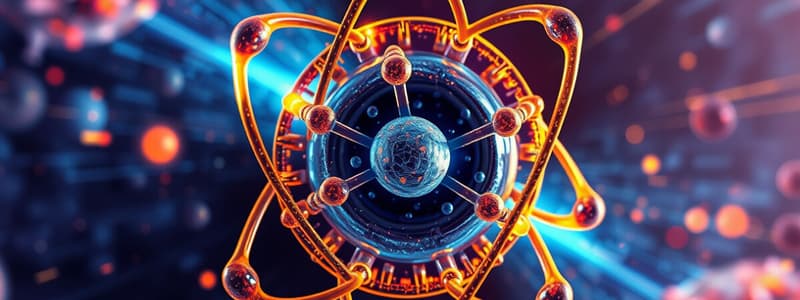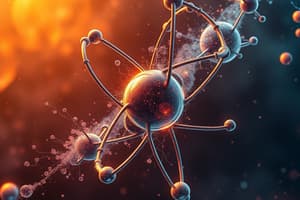Podcast
Questions and Answers
What does the weight of an object depend on, assuming gravity is constant?
What does the weight of an object depend on, assuming gravity is constant?
- The object's temperature
- The object's color
- The object's shape
- The object's mass (correct)
If an object has a mass of 4 kg, what weight does it have on Earth?
If an object has a mass of 4 kg, what weight does it have on Earth?
- 8.8 lb (correct)
- 9.8 lb
- 4.4 lb
- 12.1 lb
What is the basic SI unit for volume?
What is the basic SI unit for volume?
- Milliliter (mL)
- Cubic meter (m³) (correct)
- Liter (L)
- Centimeter cubed (cm³)
How can the volume of an irregularly shaped solid be measured?
How can the volume of an irregularly shaped solid be measured?
What is the formula to calculate the volume of a rectangular room?
What is the formula to calculate the volume of a rectangular room?
What is the volume of an object that displaces 3.2 mL of water in a graduated cylinder?
What is the volume of an object that displaces 3.2 mL of water in a graduated cylinder?
Which measurement describes the amount of matter in an object?
Which measurement describes the amount of matter in an object?
If the dimensions of a box are 2 m by 3 m by 4 m, what is its volume?
If the dimensions of a box are 2 m by 3 m by 4 m, what is its volume?
What happens to the volume of a gas when it is placed in a larger container?
What happens to the volume of a gas when it is placed in a larger container?
If the combined volume of a liquid and an irregular object is 7.0 mL and the liquid's volume is 4.0 mL, what is the volume of the irregular object?
If the combined volume of a liquid and an irregular object is 7.0 mL and the liquid's volume is 4.0 mL, what is the volume of the irregular object?
What is the basic SI unit for mass?
What is the basic SI unit for mass?
Which of the following statements correctly differentiates mass from weight?
Which of the following statements correctly differentiates mass from weight?
What tool is typically used to measure mass in a lab?
What tool is typically used to measure mass in a lab?
If two objects are balanced on a balance, what can be inferred about their masses?
If two objects are balanced on a balance, what can be inferred about their masses?
What does the term 'matter' encompass?
What does the term 'matter' encompass?
What type of microscope is mentioned as capable of imaging atoms?
What type of microscope is mentioned as capable of imaging atoms?
What would indicate that an object has a mass less than 1 kg on a balance scale?
What would indicate that an object has a mass less than 1 kg on a balance scale?
Which of the following forms is not considered matter?
Which of the following forms is not considered matter?
How do mass and weight relate to each other?
How do mass and weight relate to each other?
What would be the outcome if the scale tips in favor of a 1 kg object?
What would be the outcome if the scale tips in favor of a 1 kg object?
Mass and weight measure the same aspect of an object.
Mass and weight measure the same aspect of an object.
The SI unit for mass is the gram (g).
The SI unit for mass is the gram (g).
An object with a mass of 1 kg will have the same weight regardless of its location in the universe.
An object with a mass of 1 kg will have the same weight regardless of its location in the universe.
Matter is defined as anything that has volume but not necessarily mass.
Matter is defined as anything that has volume but not necessarily mass.
A scanning tunneling microscope can visualize atoms and their arrangements.
A scanning tunneling microscope can visualize atoms and their arrangements.
A 10 kg object has a weight of 22 lb under Earth's gravity.
A 10 kg object has a weight of 22 lb under Earth's gravity.
The volume of a liquid can be calculated using the formula for the volume of a rectangular solid.
The volume of a liquid can be calculated using the formula for the volume of a rectangular solid.
The volume of an irregularly shaped object can only be measured by calculating its dimensions.
The volume of an irregularly shaped object can only be measured by calculating its dimensions.
Matter has both mass and volume, and its basic SI unit for mass is the gram.
Matter has both mass and volume, and its basic SI unit for mass is the gram.
Gases do not have a fixed volume and expand to fill their container.
Gases do not have a fixed volume and expand to fill their container.
Flashcards are hidden until you start studying
Study Notes
Atoms and Microscopy
- Colorful images can depict individual atoms, such as cesium on gallium arsenide, using advanced techniques like scanning tunneling microscopy.
- Scanning tunneling microscope is a powerful tool that can visualize atoms, the fundamental units of matter.
Definition of Matter
- Matter comprises all tangible substances in the universe, which includes everything visible and touchable.
- Non-matter forms include energy, for example, light and sound.
- Scientifically, matter is defined by having mass and volume.
Understanding Mass
- Mass quantifies the amount of matter contained in a substance or object.
- The standard International System of Units (SI) for mass is the kilogram (kg), with grams (g) used for smaller measurements.
- Mass is measured using various types of balances, including triple beam and electronic balances.
Mass vs. Weight
- Mass indicates the quantity of matter, while weight measures gravitational force on an object.
- Weight is directly proportional to mass when gravitational strength remains constant, such as on Earth.
- An object with a mass of 1 kg has a weight of 2.2 pounds (lb) on Earth; thus, a 10 kg object weighs 22 lb.
Understanding Volume
- Volume assesses how much space an object occupies, with the cubic meter (m³) being the primary SI unit.
- Smaller volume units include cubic centimeters (cm³), liters (L), and milliliters (mL).
- Liquid volume is typically measured using containers like graduated cylinders, while gas volume corresponds to its container's volume.
Calculating Volume
- The volume of regularly shaped solids is calculated using dimensions (length × width × height).
- For irregularly shaped objects, volume can be determined through the displacement method.
Displacement Method Example
- To find the volume of an irregular object, the volume of water it displaces can be measured.
- If water's initial volume is 4.8 mL and the total volume with the object is 5.6 mL, the object's volume is 0.8 mL.
Summary
- Matter is characterized by both mass and volume, with key units being kilograms for mass and cubic meters for volume.
- Understanding these properties is essential for scientific measurements and experiments.
Atoms and Microscopy
- Colorful images can depict individual atoms, such as cesium on gallium arsenide, using advanced techniques like scanning tunneling microscopy.
- Scanning tunneling microscope is a powerful tool that can visualize atoms, the fundamental units of matter.
Definition of Matter
- Matter comprises all tangible substances in the universe, which includes everything visible and touchable.
- Non-matter forms include energy, for example, light and sound.
- Scientifically, matter is defined by having mass and volume.
Understanding Mass
- Mass quantifies the amount of matter contained in a substance or object.
- The standard International System of Units (SI) for mass is the kilogram (kg), with grams (g) used for smaller measurements.
- Mass is measured using various types of balances, including triple beam and electronic balances.
Mass vs. Weight
- Mass indicates the quantity of matter, while weight measures gravitational force on an object.
- Weight is directly proportional to mass when gravitational strength remains constant, such as on Earth.
- An object with a mass of 1 kg has a weight of 2.2 pounds (lb) on Earth; thus, a 10 kg object weighs 22 lb.
Understanding Volume
- Volume assesses how much space an object occupies, with the cubic meter (m³) being the primary SI unit.
- Smaller volume units include cubic centimeters (cm³), liters (L), and milliliters (mL).
- Liquid volume is typically measured using containers like graduated cylinders, while gas volume corresponds to its container's volume.
Calculating Volume
- The volume of regularly shaped solids is calculated using dimensions (length × width × height).
- For irregularly shaped objects, volume can be determined through the displacement method.
Displacement Method Example
- To find the volume of an irregular object, the volume of water it displaces can be measured.
- If water's initial volume is 4.8 mL and the total volume with the object is 5.6 mL, the object's volume is 0.8 mL.
Summary
- Matter is characterized by both mass and volume, with key units being kilograms for mass and cubic meters for volume.
- Understanding these properties is essential for scientific measurements and experiments.
Studying That Suits You
Use AI to generate personalized quizzes and flashcards to suit your learning preferences.




